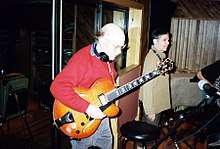Jimmy D'Aquisto
James L. D'Aquisto (November 9, 1935 – April 17, 1995) was an Italian-American luthier. He served as an apprentice to John D'Angelico from 1952 and was considered his successor after the latter's death in 1964. From his shop in Huntington, New York, then in Farmingdale and later during his "golden period" in Greenport Long Island, D'Aquisto became known as the world's greatest guitar maker from the late 1960s until his death in 1995.
Career
James D'Aquisto, born November 9, 1935, was trained by John D'Angelico. About his routine, D'Aquisto said,
"I was making $35 a week. I was like the runner: I'd go to the stores, pick up the tuners, go get the tailpieces from downtown, take the necks to the engraver, all that. I cleaned the windows, swept the floors, everything—we all did that. On Friday we put away the tools and cleaned the shop so when Monday came the place would be spotless."
Later, he learned the "rough work" of the D'Angelico style. After D'Angelico died at age 59 on September 1, 1964, D'Aquisto continued building guitars. In 1966 he moved to Huntington, Long Island, then to Farmingdale in 1973, and Greenport in 1980. He felt he would die at the same age as his mentor, and this did occur on April 17, 1995 when he was 59.[1]
D'Aquisto's name is on many guitar models from the Fender "D'Aquisto Elite" "D'Aquisto Ultra"[2] and the Hagström Jimmy. His blue "Centura Deluxe" was the inspiration for the book Blue Guitar.[3][4] His guitars have sold for tens of thousands of dollars to over $500,000. One of his guitars was the first to be worth a million dollars.[3][5]
In 2006, D'Aquisto was inducted into the Long Island Music Hall of Fame. His tools and work bench, passed down to him from D'Angelico, were given to the National Music Museum.
D'Aquisto flat top guitars

D'Aquisto flat top guitars are a group of sixteen guitars[6] made by D'Aquisto.
His flat tops are unique and carry a bracing design of his own devising. He made sixteen flat top guitars from 1973 to 1984.[6] He made two types, a grand auditorium and a dreadnought.[7] He believed the large oval sound hole produced greater projection than the typical round sound hole.[8]
He numbered his guitars from 101 to 116.[7] Number 101 was a non-cutaway auditorium as well as number 111, which he made for Laurie Veneziano and Janis Ian. Numbers 102 to 110 were his dreadnoughts. From 112 to 115, are some of his most beautiful auditorium guitars and the only flat tops he made with a cutaway. Each is a radiant blond color. He used European spruce tops and European maple back and sides for all his flat tops. Ebony for the fret board, bridge, bridge pins, and headstock overlay. His last, 116, is a dreadnought in an unusual tobacco sunburst finished in 1984.
D'Aquisto also made a few nylon-string flat top guitars.
References
- ↑ Barth, Joe (2006). Voices in Jazz Guitar: Great Performers Talk about Their Approach to Playing. Mel Bay. pp. 241–. ISBN 978-0-7866-7679-8.
- ↑ "1984 Fender D'Aquisto Elite". Retrieved September 29, 2006.
- 1 2 Vose, Ken (1998). Blue Guitar. San Francisco: Chronicle Books. ISBN 0-8118-1912-4.
- ↑ Schmidt, Paul William (1998). Acquired of the Angels: The Lives and Works of Master Guitar Makers John D'Angelico and James L. D'Aquisto (2 ed.). Lanham, Maryland: Scarecrow Press. ISBN 978-1-57886-002-9.
- ↑ Nager, Larry (October 11, 2001). "To Guitarists He's a Guru". The Cincinnati Enquirer.
- 1 2 Ilowite, P.G. (1994). "D'Aquisto Flat Tops". 20th Century Guitar. pp. 44–45, 75.
- 1 2 Tsumura A, Guitars The Tsumura Collection. Kodansha International LTD. D'Aquisto Serial Numbers. 1987, 192.
- ↑ Olsen T, Luthier The D'Aquisto Foundation Help complete the D'Aquisto exhibit at the National Music Museum. Guitar Player. 1978.